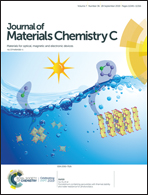Mn2+-Based narrow-band green-emitting Cs3MnBr5 phosphor and the performance optimization by Zn2+ alloying†
Abstract
To discover new narrow-band green-emitting phosphors is a challenge for backlighting light-emitting diodes (LEDs) used in liquid crystal displays (LCDs). The synthesis and optical properties of Cs3MnBr5 are demonstrated herein. The intrinsic Mn2+ luminescence without concentration quenching leads to intense green emission at 520 nm with narrow full width at half maximum of 42 nm and high photoluminescence quantum yield (PLQY) of 49% under the excitation at 460 nm. When a small amount of Zn2+ is introduced into Cs3MnBr5, the luminescence intensity decreases slightly. However, the thermal stability of Cs3MnBr5 is improved from 82% to 87% with the intensity values at 423 K compared to that at 298 K. The white LED device fabricated using Cs3Mn0.96Zn0.04Br5 (green) and K2SiF6:Mn4+ (red) phosphors with a blue LED chip exhibit a high luminous efficiency (107.76 lm W−1) and wide color gamut (101% National Television System Committee standard (NTSC) in Commission Internationale de L’Eclairage (CIE) 1931 color space), demonstrating its potential application in wide color gamut LCD backlights.



 Please wait while we load your content...
Please wait while we load your content...